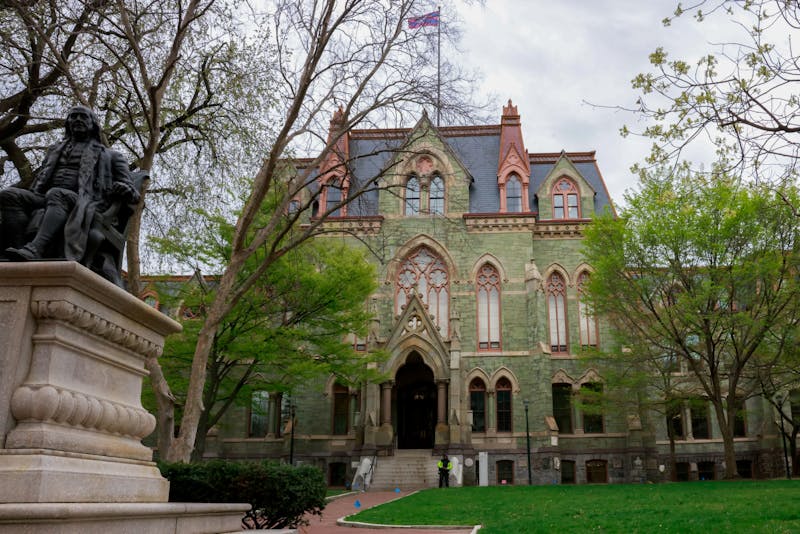College senior Jessica Ley has been a work-study student at the information desk in Houston Hall for all of her four years at Penn.
Ley, who is on financial aid, has kept her school-year job so she can maintain a steady stream of spending money -- an apparent necessity on an urban campus like Penn's.
"It doesn't go towards my loans -- it just goes to my regular paycheck."
Ley is just one of the thousands of students who seek work-study employment on Penn's campus each year. And according to the Student Employment Office and Student Financial Services, this number is rising.
Over the past few years, as the national economy has struggled, it is not only parents who are bearing the brunt of financing their childrens' college years.
More and more students are accepting work-study jobs as part of their financial aid packages, either to help pay for their education or to cover the cost of student living.
Student Employment Office Director John Rudolph said that he has seen the pinch of the economy affect Penn students. He added that colleagues at other institutions have also noticed a rise in the number of students seeking employment during their college careers.
"I think that it is the result of students not being able to find paid internships over the past summers," Rudolph said, adding that once students get to school, they find it vital for their financial situations to accept work-study jobs.
Last year, there were over 240 more students participating in work-study programs than in previous years. Rudolph also said that during the academic year, there are approximately 3,000 work-study students, nearly 700 of which work over the summer months.
Student Financial Services Director Bill Schilling said that this year, between 4,500 and 5,000 undergraduate students are receiving financial aid from forms processed in SFS. He noted that on top of this number, there are others who are receiving financial assistance outside of Penn.
Work-study is only offered to students who demonstrate eligibility for some form of financial aid.
During classes, students are only allowed to work up to 20 hours a week, while during off-months they can work up to 40 hours.
"Our priority is academics," Rudolph said. "We don't want work to be interfering with that."
But he said that another trend in student employment shows that students are now looking to their jobs as a way of learning outside the classroom. He said that in the past few years, students have grown away from routine jobs entailing administrative tasks and have opted for more practical employment geared towards community service and field research.
"More students are looking to work-study today as a resum‚-builder for the future," Rudolph said.
And with the average job offering between $7-8 per hour, Rudolph said that "it goes beyond the money."
"I think that most students are really finding jobs now that supplement their field of study."
In addition to nearly 20 hours of class a week, College junior Emily Anderson also spends between 15 and 20 hours a week analyzing genetic maps and creating breeding schemes as part of her work-study job in the Bucan Genetic Laboratory.
Anderson agreed that for her, "money never actually came into it." As a work-study student in a genetics laboratory since her freshman year, Anderson said that she first determined what type of job would be most educational for her and then she figured out the work-study part of it.
"It is definitely a learning experience," she said, adding that in some ways the job has been more informational than some of her biology classes.
But Anderson noted that some of her friends who were not eligible for work-study did not have such an easy time nabbing a campus job that interested them. She noted that she has found that employers are often more willing to hire students whose salaries will be supplemented with federal money through the work-study program.
Schilling, who deals with budgeting student financial aid packages, noted that "everything is going up," in terms of the number of students applying for financial aid, the number receiving it and the number of students who accept the work-study jobs included with the offer.
He agreed with Rudolph and said that this also might be attributed to the fact that there is less availability of non-work-study jobs.
He added that students' economic environment at home often affects the actions they pursue at Penn to help supplement their own incomes.
"I have a sense that we have seen a significant increase in the number of cases where parents have become unemployed," he said.
Schilling added that situations can also be strenuous when parents who were unemployed find jobs at a lower income rate than their previous employment.
"We are seeing more of that this year than we have in quite a while."
But Rudolph said that work-study jobs will not be running out anytime soon.
"There are certainly more positions than we have students to fill," he said.
The Daily Pennsylvanian is an independent, student-run newspaper. Please consider making a donation to support the coverage that shapes the University. Your generosity ensures a future of strong journalism at Penn.
DonatePlease note All comments are eligible for publication in The Daily Pennsylvanian.








